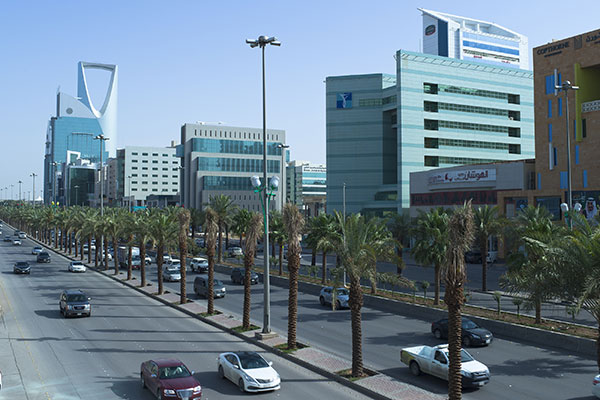
Saudi Arabia's economic growth is expected to further accelerate
to 1.9 per cent in 2019
IMF raises Saudi economic growth forecast
RIYADH, May 6, 2018
The International Monetary Fund (IMF) has marginally raised Saudi Arabia’s 2018 economic growth forecast to 1.7 per cent as against the previous 1.6 per cent following the rise in crude oil prices, a report said.
This is expected to further accelerate to 1.9 per cent in 2019 (previous estimate: 2.2 per cent) on account of a possible increase in oil production post the expiry of output cut agreement, added the latest Economic Research by Al Rajhi, a leading financial services provider in Saudi Arabia.
Under the Kingdom’s privatization program to raise around SR35-40 billion ($9.3 billion-$10.65 billion) by 2020 through asset sales, the government would engage in privatization of its football clubs, four flour mills and a water desalination production facility.
The plan also calls for corporatization of ports, privatizing of some transportation sector services, and making King Faisal Specialist Hospital & Research Centre a non-profit organization. The plan (privatization/PPP) would also lead to net savings (capex & opex) of SR 25-33 billion for the Saudi government by 2020, while creating 10-12k jobs by 2020, the report said.
Saudi Arabia’s Q4 2017 GDP figures showed that the economy contracted 1.2 per cent y-o-y (-0.4 per cent y-o-y in Q3 2017), dragged down by the 4.3 per cent decline in oil sector due to the output cut deal. However, the non-oil sector grew 1.3 per cent y-o-y, compared to 2.1 per cent y-o-y growth in Q3 2017, backed by government spending.
Moody’s affirmed Saudi Arabia’s sovereign credit rating to A1 on expectations that the government’s structural reforms would reduce the Kingdom’s reliance on oil and the continued fiscal consolidation would stabilize the government’s debt burden below 30 per cent of the GDP.
Total reserves of the Saudi Arabian Monetary Agency (Sama) rose sequentially after falling for two straight months in March 2018. Government reserves with Sama stood at SR 605.4 billion (including Government current account) as of March 2018, recording a monthly fall of 0.5 per cent. Meanwhile, the deposits declined for the second consecutive month in March, down 0.6 per cent m-o-m (-0.5 per cent y-o-y), whereas credit to the private sector rose 0.6 per cent m-o-m (-0.7 per cent y-o-y) in March.
Q4 2017 labour data indicated that the total unemployment rate rose to 6.0 per cent from 5.8 per cent in Q3 2017, while the Saudi unemployment rate remained steady at 12.8 per cent for the same period.
Real Estate Price Index fell at a slower pace of 1.5 per cent y-o-y in Q1 2018, as against a fall of 3.3 per cent y-o-y in Q4 2017, as residential and commercial property prices dropped at a slower pace.
Banking sector profits surged 22.4 per cent y-o-y to stand at SR 4,143 million in March 2018, while on a monthly basis, profits rose 8.9 per cent. The cumulative banking sector profits for Q1 2018 stood at SR 12,113 million, up 7.6 per cent y-o-y.
Money Supply (M3) rose 0.2 per cent y-o-y in March 2018 to SR 1,782 billion, versus the yearly rise of 2.0 per cent in February, supported by the rise in M1 (+2.2 per cent y-o-y). Meanwhile, as per the weekly money supply data by Sama, M3 may remain broadly stable in April 2018.
Consumer spending continued to climb higher as indicated by the point-of-sale (POS) transaction +19.8 per cent y-o-y in March 2018, versus the rise of 8.7 per cent y-o-y in February, led by rise in ‘Restaurants and Hotels’ (+41.7 per cent y-o-y), ‘Food and Beverage’ (+25.9 per cent) and ‘Clothing and Footwear’ (+14.9 per cent y-o-y) segments. ATM transactions rose 5.3 per cent y-o-y in March 2018 compared to the rise of 2.7 per cent y-o-y in February.
Personal transfers (remittances) by Saudi nationals advanced 40.6 per cent y-o-y in March 2018, while remittances by non-Saudi nationals was almost flat (+0.4 per cent y-o-y) in the same month.
Crude oil prices (Brent July futures contract) gained 8.5 per cent m-o-m in April 2018, due to geopolitical concerns in Syria and Iran coupled with easing trade war concerns between the US and China. Further, the drop in the US crude oil stockpiles also supported crude oil prices. Meanwhile, Saudi Arabia’s crude oil production edged down on a monthly basis in March 2018.
Kingdom’s non-oil exports advanced for the fifth consecutive month, up by 35.8 per cent y-o-y in February 2018 (+18.0 per cent y-o-y in January 2018), whereas the non-oil imports fell 1.1 per cent y-o-y in February 2018 (-13.2 per cent y-o-y in January 2018), Al Rajhi said in the report.
Cost of living index (base year 2013) grew by 2.8 per cent y-o-y in March 2018, owing to slower rise in the ‘Housing, Water, Electricity, Gas’ and ‘Food & Beverage’ sectors. On a monthly basis, the index slipped 0.2 per cent in March 2018 as against the rise of 0.1 per cent m-o-m in the previous month.
Saudi Arabia raised SR5 billion in April through domestic sukuk issuance under the SR-denominated sukuk program. The government sold SR3.8 billion of 5 year bonds, SR750 million of seven-year bonds and SR450 million of 10-year bonds. Further, the Kingdom also raised $11 billion via international bond sales. The government issued $4.5 billion of 7 year bonds, $3 billion of 12 year bonds and $3.5 billion of 31 year bonds. – TradeArabia News Service







